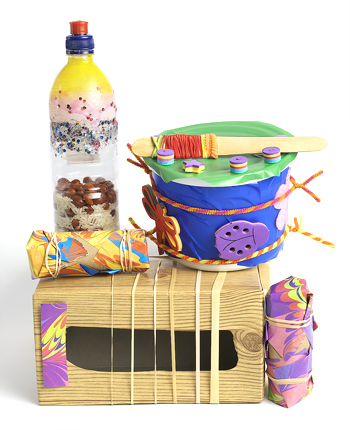Hand-Made Band
Â
A fun, eco-friendly activity that uses recycled goods from home to create shaker and string instruments that allow for the exploration of rhythm and sound.
Â
Â
• Use recycled materials to create a creative instrument.
•  Learn about rhythm and sounds created by different instruments.
• Work together to create unique sounds when instruments are played together.
Â
Before You Start: Have children collect used toilet paper rolls or paper towel rolls, plastic food containers (with lids,) tin cans or plastic water bottles, rubber bands, and tissue boxes. You will also need paint and decorating items (like glitter, stickers, stamps, etc.), unsharpened pencils, and uncooked rice and beans to use as the filling for shakers.
Â
Make sure all cans and containers are washed and dried thoroughly. Let the children decorate the containers with craft items of choice. It may be easier to wrap some of the containers with paper than to paint on the surface. To make a guitar, have the children wrap rubber bands of varying thickness around the opening of the empty tissue box. “Plucking†the bands will create different kinds of sounds over the opening. To make a cardboard shaker, seal up one end of the toilet paper roll with thick paper held in place tightly with a rubber band. Pour in some uncooked rice and/or beans inside and seal the other end of the shaker. To make a plastic shaker, pour the rice/beans into a plastic water bottle and replace the lid. To make a guiro, children can run an unsharpened pencil along the texture of the tin can or plastic water bottle. Tape a craft stick or pencil to one side of the can to act as a handle. Tape open ends of the cans to avoid sharp edges. To make a drum, place the lid on the plastic food container and let the children pat on it with their hands or the eraser end of an unsharpened pencil. Have the children practice “playing their instruments.†Set different rhythms for them to follow by clapping your hands.
Â
Let the students have a “solo†or create a symphony by seating students in sections by instrument and when you point to them they play. No instrument will sound exactly the same, and the students will have fun exploring the sounds.







